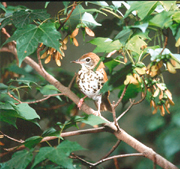Spring Arrives
On Wings of Songbirds
By Kathy Reshetiloff
I've noticed that my mornings
aren't as silent as a few months ago. Before the sun has even
risen, I'm awakened by a chorus. I used to spend my Saturday mornings
sipping coffee and scanning the grey landscape for any sign of
life. But now the little woodland behind my house is a flurry
of activity as migratory songbirds, absent since late fall and
winter, have returned.
 Migratory birds nest in North America but spend their winters
in Mexico, the Caribbean, and South and Central America. It's
not the weather that motivates these birds to move, but food.
Many songbirds feed exclusively on pollen or insects. These foods
are not available here in winter so they migrate following the
food. As spring returns to North America, so do the birds, again
following abundant food sources to their nesting grounds.
Migratory birds nest in North America but spend their winters
in Mexico, the Caribbean, and South and Central America. It's
not the weather that motivates these birds to move, but food.
Many songbirds feed exclusively on pollen or insects. These foods
are not available here in winter so they migrate following the
food. As spring returns to North America, so do the birds, again
following abundant food sources to their nesting grounds.
More than 360 species of birds make this annual migration, flying
between wintering grounds in the tropics and breeding grounds
in North America and the Arctic. Some of these birds are common
to us: the ruby-throated hummingbird, gray catbird, purple martin,
barn swallow and chimney swift. Others, such as the red-eyed vireo,
scarlet tanager, wood thrush and Cape May warbler, may be familiar
only to bird watchers.
The importance of migratory birds cannot be overlooked. Birds
are our best natural insect control, eating tons of insects annually.
As green leaves emerge each spring, so do millions of caterpillars
and insects. Coinciding with this event, an array of birds---orioles,
vireos, flycatchers, warblers and swallows---return to North America
to feast upon the abundant insects.
Many species of migratory birds are declining due to loss of habitat.
Habitat is simply the food, water, cover and breeding areas needed
for survival. Development continues to fragment or destroy the
vital meadows, forests and wetlands these birds depend upon, both
here and in their tropical wintering grounds.
Homeowners can help migratory birds by planting native trees,
shrubs and other plants on their property to provide crucial food
and cover for birds. Birds requiring smaller spaces as habitat
may stay on your property and nest. Other birds which need different
or larger habitat types can benefit as well, stopping in for food
or a safe place to rest. If you own a larger piece of property,
consider conserving or restoring forests, meadows and wetlands
to provide critical nesting habitat.
If you are a coffee drinker, you can conserve habitat and protect
more than 150 migratory bird species just by choosing shade-grown
coffee. Traditionally, coffee in the Americas was grown under
existing forest cover or under cover planted by the coffee farmer.
During the 1970s, demands for higher yields caused many farmers
to convert their shade coffee farms to sun plantations. In order
to produce a higher yield, these farms require more fertilizers,
pesticides and herbicides. As plantations are converted from shade
to sun, the diversity of birds plummets. A sun plantation supports
only 5 to 25 percent of the number of birds in shade plantations.
Shade coffee farms provide protective cover to forest dependent
birds. Trees and leaf litter harbor many insects, spiders and
other small prey these birds needed for food. Studies have found
that shaded coffee plantations, with a diversity of tree species,
support a variety of birds second only to an undisturbed forest.
Birds that benefit include resident birds as well as those that
bring color and song to North America in the spring.
Coffee is one of the most valuable legal exports in the world,
and North America accounts for more than one third of the consumption.
Once considered a specialty item, shade grown coffee can be found
in many grocery stores and coffee shops. If you do not see shade
varieties in your favorite store, ask the manger to stock some.
By selecting shade grown coffee you are protecting important wintering
habitat for birds like the ruby-throated hummingbird, wood thrush,
red eyed vireo, oven bird, scarlet tanager, indigo bunting and
Baltimore oriole.
Not a coffee drinker? You can help by reducing your pesticide
use. Pesticides intended to control specific pests sometimes harm
or kill other wildlife. Forty pesticide ingredients have been
linked to bird die-offs. Chemical compounds often implicated are
organophosphorus and carbamate insecticides. If you must use a
pesticide, try low impact pesticides like dormant oils, insecticidal
soaps. For more information, contact the University of Maryland
Cooperative Extension Service at 301/405-4579 or www.agnr.umd.edu/CES/.
Cat owners can protect birds as well. At least 68 million pet
cats live in the United States. Studies have shown that birds
make up 20 or 30 percent of cats' prey. Cat owners can reduce
bird deaths by simply keeping their cats indoors. Indoor cats
also lead healthier and safer lives. For more information, contact
the Cats Indoors! Campaign at 202/778-9666 or www.abcbirds.org.
Kathryn Reshetiloff is employed by the Fish and Wildlife Service, U.S. Department of the Interior. Illustration by Laurie Hewitt, U.S. Fish and Wildlife Service.
|
Back
|

